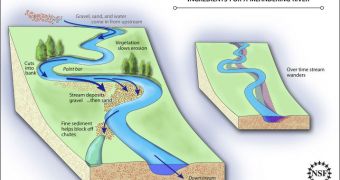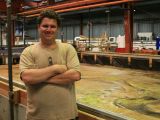Scientists at the University of California in Berkeley (UCB) have managed to construct and sustain a large-scale, meandering river model in the laboratory, analyzing the most important factors that keep a flowing water healthy in the long run. Surprisingly, their reverse-engineering study has shown that sand is of the utmost importance in water restoration. This is also bad news, because most conservation efforts made until now did not focus on the material at all. Sand is known to conflict with salmon-spawning habits, and has therefore been largely avoided, the National Science Foundation reports.
Naturally, the team has also again confirmed the importance of fixed vegetation in maintaining a river healthy. Plants and trees play the dual role of preventing erosion, and also of reinforcing the banks, thus sustaining biodiversity. According to the team, the sand plays an even more important role, especially in building point bars, but also in blocking off cut-off channels and chutes. These formations are tributaries that might start and detract from the flow and health of the stream.
Gravel (sand), fine sediments, vegetation and water were the main ingredients for the simulated flood plain, which behaved in very much the same amount of time its larger cousins do over years, rather than hours, and at ten times or more the volume. Christian Braudrick, the leader of the UCB efforts, said that the experts could see the river catching life right under their eyes, and that, in several hours, a number of formations that usually took years to take shape in regular rivers appeared.
In a paper published in the September 28 issue of the journal Proceedings of the National Academy of Sciences (PNAS), the team details how, in some 130 hours of simulation, the small model had already built point bars and other structures from the sand that it had available at the beginning of the exercise. Noticing the structures was easy, because scientists used colored sand for gravel. They were thus able to notice the formation of the bars in real time.

 14 DAY TRIAL //
14 DAY TRIAL // 
